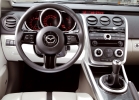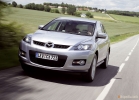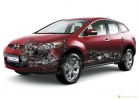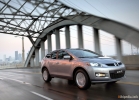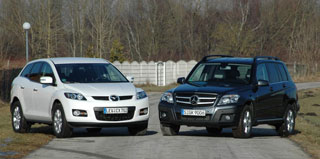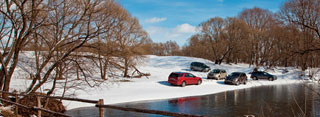Test drive Mazda CX-7 2007-2009 SUV
Mazda CX-7 & Nissan Murano
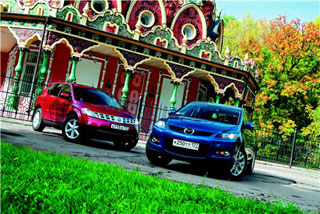 Mazda CX-7 and Nissan Murano make it turn after them. But what hides their fitnessoblik? What feelings cause the hot hearts of these cars.
Mazda CX-7 and Nissan Murano make it turn after them. But what hides their fitnessoblik? What feelings cause the hot hearts of these cars. We will talk about the Japanese car Nissan Murano, and the Mazda CX-7 was created specifically for American consumers, and their main market is located outside the ocean, but in our test they met on the picturesque expanses of the Yaroslavl region.
At the end of the last century, more than half of all funds allocated by automakers for experimental design work was spent on developing traditional SUVs, pickups and minivans. But the demand for classic SUVs began to gradually fall, minivans also lose popularity. The emphasis began to shift towards multi -purpose cars of crossovers. In 2006, the segment of light SUVs-investigators in the Russian market grew by 62.1%, and in the first half of 2007 he showed an increase of 95% with the total number of cars sold 64798 units. Nissan Murano and Mazda CX-7 are one of the brightest representatives of the crossover detachment.
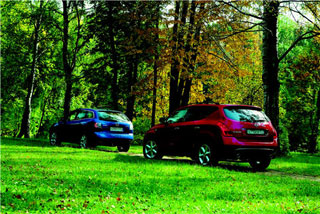 True, for each of the brands, these models pursue different goals. SC-7 claims the role of a leader in the segment and should play the role of a locomotive of sales for the company in the Russian market. Murano, whose debut in America took place back in 2003, and sales in Russia started at the end of 2006, this is a kind of show-stop that attracts attention and expresses the emotional component of the Nissan brand. At the same time, the Nissan representative office in Russia fateful rates on Murano, in my opinion, does not make a crossover compared to competitors-classmates of roads: its price is about 1545,000 rubles, that is, it is more expensive than CX-7 by 300 thousand, and, for example, Mitsubishi Outlander XL for 340 thousand rubles.
True, for each of the brands, these models pursue different goals. SC-7 claims the role of a leader in the segment and should play the role of a locomotive of sales for the company in the Russian market. Murano, whose debut in America took place back in 2003, and sales in Russia started at the end of 2006, this is a kind of show-stop that attracts attention and expresses the emotional component of the Nissan brand. At the same time, the Nissan representative office in Russia fateful rates on Murano, in my opinion, does not make a crossover compared to competitors-classmates of roads: its price is about 1545,000 rubles, that is, it is more expensive than CX-7 by 300 thousand, and, for example, Mitsubishi Outlander XL for 340 thousand rubles. And yet we decided to compare CX-7 and Murano. Firstly, because they are close in size, and secondly, because they have motors about the same power. And finally, the main thing: their design in most people causes very positive emotions.
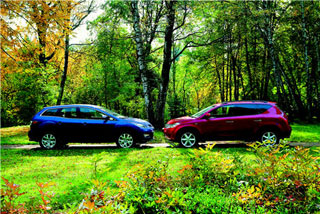 At the target!
At the target! Which of the cars is more beautiful? I think here you can argue to infinity both deserve five with a plus! In my opinion, Murano looks more aggressive and shocking than the SC-7. Mazda crossover is more elegant and sports. The appearance of Nissan is closer to the off -road style. CX-7 is somewhat reminiscent of a sports station wagon. Murano stands out with bright details: massive front and rear blocks, an evil false radiator grille, pumped up wheel arches. All these catchy elements of the exterior are folded into a harmonious ensemble. It is difficult to highlight some bright accents in the form of CC-7, but, despite this (and maybe thanks to this), the car looks very purposeful. It is curious, by the way, that Nissan and Mazda designers use the same technique to give dynamism the appearance of their crossovers. Pay attention to the lower line of the side windows: both Murano and the CX-7, it noticeably rises from the side mirrors to the rear of the car. Even in statics, this line creates a visual sense of movement.
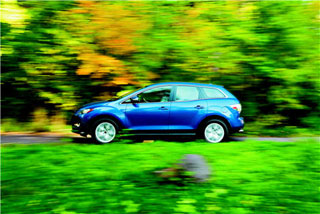 Some other details are also paid attention to. The door handles of the CX-7 are painted in the color of the body, and in Murano they are chrome. The CX-7 has a large, strictly parallel to the ground front overhang. In Murano, it is visually much smaller than a powerful defense of the motor compartment set. The CC-7 has no luggage relings (special holes are provided for attaching baggage crosses on the roof), for Murano this practical element of the exterior fits very successfully into the appearance. Outwardly, Mazda and Nissan are different, but they are similar in energy and dynamics as soon as possible to be driving these cars and evaluate their true potential. Having settled down at the wheel, I understand that the inner world of these Japanese crossovers is different.
Some other details are also paid attention to. The door handles of the CX-7 are painted in the color of the body, and in Murano they are chrome. The CX-7 has a large, strictly parallel to the ground front overhang. In Murano, it is visually much smaller than a powerful defense of the motor compartment set. The CC-7 has no luggage relings (special holes are provided for attaching baggage crosses on the roof), for Murano this practical element of the exterior fits very successfully into the appearance. Outwardly, Mazda and Nissan are different, but they are similar in energy and dynamics as soon as possible to be driving these cars and evaluate their true potential. Having settled down at the wheel, I understand that the inner world of these Japanese crossovers is different. The front panel of SC-7 is two-level. One visor passes throughout the width of the cabin, shading the information display, and the second, additional, covers the dashboard. Having broken the panel by two floors, designers visually reduced its size, so reducing the surface under a highly tilted windshield. By the way, to improve aerodynamics, the angle of inclination of the windshield CC-7 is 66 is the greatest importance among existing models in this class.
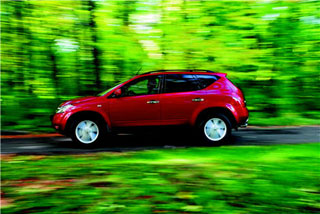 At the wheel of the CX-7, you do not feel like the driver of the SUV planting typically passenger: the legs are extended, the steering wheel is located vertically. Quite tough chairs with pronounced side support are well held in corners. And at the wheel of Murano, I felt like a minivan driver thanks to a high vertical landing and a huge front panel, at the top of which there are shelves for papers.
At the wheel of the CX-7, you do not feel like the driver of the SUV planting typically passenger: the legs are extended, the steering wheel is located vertically. Quite tough chairs with pronounced side support are well held in corners. And at the wheel of Murano, I felt like a minivan driver thanks to a high vertical landing and a huge front panel, at the top of which there are shelves for papers. The combination of devices of both crossovers is focused on the driver. But the interior design of Murano on the background of the CC-7 looks simpler. The central console put forward forward, a combination of instruments in the spirit of the Nissan 350Z sportkup, it would seem, should bring a touch of sports, but inexpressive yellow devices, the simple graphics of the on -board computer and unassuming plastic spoil the impression.
Murano’s front seats have some amorphous and soft, steering column is regulated only in height in the American manner, significantly changing the angle of inclination when setting up. However, it will be easy to get a set of Nissan by the wheel, which, incidentally, is also typical Americanism.
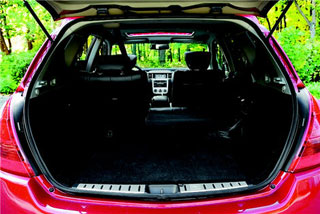 In the room in the back seat, Murano wins here with comfort three adults will be able to accommodate. Continuing three in the back row CX-7 is not so convenient. But in terms of the luggage compartment, the convenience of transforming the salon in these cars in these cars (the rear seats are easier to fold: it is enough to pull special levers in the trunk, and the backs of the seats fall down, forming an even floor).
In the room in the back seat, Murano wins here with comfort three adults will be able to accommodate. Continuing three in the back row CX-7 is not so convenient. But in terms of the luggage compartment, the convenience of transforming the salon in these cars in these cars (the rear seats are easier to fold: it is enough to pull special levers in the trunk, and the backs of the seats fall down, forming an even floor). Running in a flat area
Under the hoods of crossovers, motors are installed that are fully consistent with the sports image of these cars. On the CX-7 there is a turbocharged engine with a volume of 2.3 liters and a capacity of 238 hp. (350 nm/2500 rpm). We recall exactly the same engine, the hot hatchback of Mazda 3 MPS is equipped, though the cross-breed power unit is deformed so that it can consume gasoline with an octane number of 95. 8.3 s is required to accelerate up to 100 km/CX-7. The engine briskly disperses the car from the bottom, making acceleration at the same time comfortable and sports. The maximum speed of the car is limited by electronics at a mark of 181 km/h.
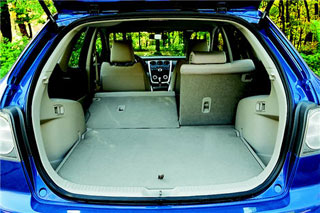 It is curious that on Murano they did not put on such a strict electronic collar, this crossover is able to develop 200 km/h. V6 engine with a capacity of 234 hp It accelerates Murano to hundreds of 9.5 s, but the sensation of dynamics conceals the nature of the work of the C-Tronic CVT (Continouse Variable Transmission). When accelerating, the engine freezes at high speeds, and since the programs do not switch (there are simply no them in the variator), it is not felt and grabbing. When overtaking, I just want to stick a low gear, but the variator does not know how to do this, however, there is a manual switching mode, but you need to get used to it.
It is curious that on Murano they did not put on such a strict electronic collar, this crossover is able to develop 200 km/h. V6 engine with a capacity of 234 hp It accelerates Murano to hundreds of 9.5 s, but the sensation of dynamics conceals the nature of the work of the C-Tronic CVT (Continouse Variable Transmission). When accelerating, the engine freezes at high speeds, and since the programs do not switch (there are simply no them in the variator), it is not felt and grabbing. When overtaking, I just want to stick a low gear, but the variator does not know how to do this, however, there is a manual switching mode, but you need to get used to it. The automatic 6-band gearbox Mazda switches on time, quickly and without jerking. However, in the torn mode of traffic, for example, when driving in a column in the city stream, so as not to lag behind a walking car, it is better to use a manual switching mode. I note that in Europe the CC-7 will be sold only with a manual gearbox, and in Russia exclusively with a machine gun.
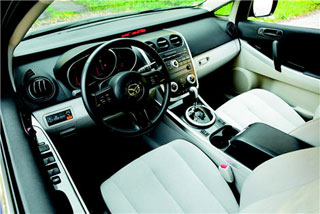 Full-wheel drive schemes SC-7 and Murano are similar. In standard road conditions, torque is transmitted to the front wheels. During their slip, the electronics throws the craving to the rear axle. Thus, the torque entering the wheels of the front and rear axis, respectively, may change in the ratio from 100/0 to 50/50. The main difference in all-wheel drive systems: Murano has a compulsory blocking mode of multi-disc clvering connecting the rear axle, and in the CC-7 blocking occurs only automatically.
Full-wheel drive schemes SC-7 and Murano are similar. In standard road conditions, torque is transmitted to the front wheels. During their slip, the electronics throws the craving to the rear axle. Thus, the torque entering the wheels of the front and rear axis, respectively, may change in the ratio from 100/0 to 50/50. The main difference in all-wheel drive systems: Murano has a compulsory blocking mode of multi-disc clvering connecting the rear axle, and in the CC-7 blocking occurs only automatically. SC-7 and Murano are real speeds, these cars are perfectly adapted for long-distance travels. However, the CC-7 in corners and on poor asphalt feels more confident. Managing the Mazda crossover, I sometimes forgot that I was driving, in principle, a large and heavy car with a high center of gravity, SC-7 kept the road no worse than a prestigious sedan. In terms of controllability, the CX-7 largely resembles BMW crossovers. Murano, on the contrary, did not allow you to forget about its great mass and high center of gravity: when driving at high speed, secondary fluctuations in the body showed on the broken asphalt, and tangible rolls in quick turns. Murano reactions during rebuilding are quite lazy, but, however, are accurate and
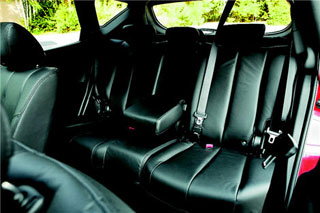 unambiguous. In the desert road sections in the Yaroslavl region, I accelerated on the CC-7 to the maximum 180 km/h and enjoyed driving. The threshold of comfortable speed on Murano for me was limited to 140150 km/h (may these lines read the traffic police officers).
unambiguous. In the desert road sections in the Yaroslavl region, I accelerated on the CC-7 to the maximum 180 km/h and enjoyed driving. The threshold of comfortable speed on Murano for me was limited to 140150 km/h (may these lines read the traffic police officers). However, if at high speeds it is more comfortable in Mazda, then in civilian traffic modes it is more convenient for Nissan to cope with broken asphalt when driving in the city stream. He equally calmly overcomes large and small irregularities, asphalt waves. The impression only spoils that the suspension lacks a tangible supply of energy intensity.
Having met these pro -American cars on Russian roads, I made my conclusions. Nissan Murano, I think, is suitable for those who appreciate in the car primarily comfort and thoroughness, but do not against excess attention to their person. And the Mazda CC-7 crossover for people who love cars not only for status, design and versatility, but also for sparkles in character.
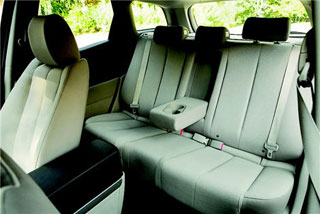 Specifications
Specifications Mazda CX-7 Nissan Murano
Dimensions, mm 4675x1870x1645 4770x1880x1745
Base, mm 2750 2825
Track, mm 1615/1610 1630/1625
Equipped mass, kg 1760 1865
Type of engine gasoline 4-cylinder with turbocharged gasoline 4-cylinder with turbocharged
Working volume, cubic meter. cm 2261 2261
Max. Power, L.S./O/min 238/5000 234/6000
Max. moment, nm/rpm 350/2500 318/3600
Transmission Automatic 6-band Vishoner Variator
Full drive automatically
connected rear axle is full with automatically
connected rear axle
Max. Speed, km/h 181 200
Acceleration time 0100 km/h, with 8.3 9.5
Fuel consumption, l/100 km 11.5 12.3
Tank volume, l 69 82
price, rub. 1245000 1545000
Igor Komarov
Photo by Yana Segal
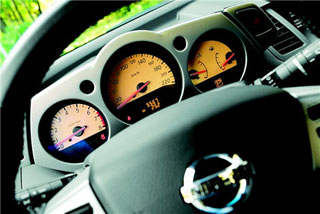
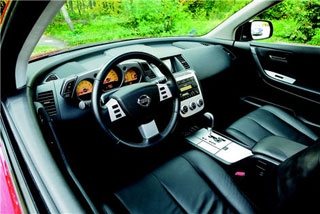
Source: Avtopanorama magazine

